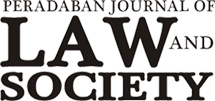Author Guidelines
Please read the author's guidelines for the preparation manuscript. The author who submits a manuscript should comply with the author's guidelines and template. If the submitted manuscript does not comply with the guidelines or using a different format, it will be rejected before being reviewed.
- Submitted Manuscripts should be manuscripts which have not been published or are under consideration elsewhere.
- The manuscript must be sent through Online Submission.
- The citations and references should follow the American Psychological Association (APA) 6th Edition. Please use Reference Manager Applications like EndNote, Mendeley, Zotero, etc..
- Manuscripts must writed in English, Arabic, or Bahasa Indonesia.
- Make sure that the manuscript is prepared using the Article Template.
Article Types
Peradaban Journal of Law and Society accepts manuscripts in Research Manuscripts, Non-Research Manuscripts, and Book Review.
Research Manuscripts
These are Original Research articles that report detailed research and are classified as primary literature. Their format includes an introduction and background problems, review of literature and hypotheses development, research method, results, interpretations of findings, discussion, and conclusion.
Non-Research Manuscripts
This category includes articles that focus on conceptual analysis, critique, and theoretical development (such as Conceptual Articles and Literature Reviews). These papers provide reports, discussions, and critical analyses of important and new topics related to the field of law. These articles do not report new empirical data, but instead utilize existing literature, legal doctrines, or important case law as the foundation for constructing a strong argument.
Book Review
We welcome reviews about academic books, monographs or edited volumes, policy publications, or reviews on past works that are relevant for re-engaging in theory, policy, and practice related to contemporary issues in the field of law.
Article Format
- Manuscripts must be typed in MS Word, 12-pt font;1.15-spaced on A4-sized paper.
- The word limit for the submission is 4500–8000 words.
- The word count includes: title, abstract, full text, tables, and references.
- Longer papers may be submitted and will be considered at the discretion of the editors; please justify why you are requesting a word count greater than 8,000 words.
Article Structure
1. Research Manuscripts
2. Non-Research Manuscripts (Conceptual/Review)
3. Book Review
Peradaban Journal of Law and Society does not require any rigid format for conducting a book review. Reviewers should feel at liberty to approach the review in their own style with the broader aim of contextualizing the work in the literature or policy developments at the time of publication.



